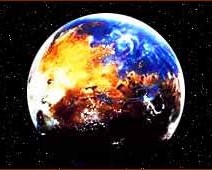 |
| What We Know About the Red Planet | ||||
| History | Water | Ice | Air | Canals |
| Seasons | Mountains | Rocks | SandDunes | Rift Valley |
| Moons | Dust Storms | Stats | Closest | Kid Pix |
| Lunar | Movies | Life Search | Wanted | Exploring Mars |
Only two of four terrestrial planets have satellites:
The Moons of Mars
Among the nine planets in our Solar System, the four nearest the Sun are referred to as terrestrial. Earth is third from the Sun and Mars is fourth. Among the four terrestrial planets, only Earth and Mars have natural satellites.
Phobos by Mariner 9
Deimos by Viking 2Phobos and Deimos were detected first by American astronomer Asaph Hall at the U.S. Naval Observatory in Washington, D.C. Peering through his 26-inch telescope, Hall spotted what he called a "Mars star" moving against the black background of space near the Red Planet. He scribbled in his log that Phobos was "faint and difficult to observe."
- Earth has its Moon.
- Mars has two tiny natural satellites, Phobos and Deimos, named after the horses of the mythical Roman god of war, Mars.
More than a century later, we know what Phobos looks like. Interplanetary probes have beamed photos of it to Earth.Deimos appears smooth in some photos, but is covered with craters. It is less than nine miles from end to end.
- The U.S. spacecraft Mariner 9, launched in 1971, transmitted the first close-up images of Phobos and Deimos. The moon is about 16 miles across its longest dimension. Craters as small as 984 feet are visible in the mariner 9 image.
- Later close-up photography by NASA's Viking 1 and 2 spacecraft in 1977 revealed Phobos is a mere 18 miles long, 13 miles wide and 12 miles deep. By comparison, Earth's moon is a mammoth 2,160 miles in diameter.
The photos showed Phobos is covered with craters and deep depressions. It's shaped something like an apple with a bite out of it.
What is it? Phobos is the larger of Mars' two natural satellites, but is it actually a Martian moon? Or is it an asteroid captured by the gravity of Mars? Scientists have been asking about that since Hall discovered Phobos in 1877. Answers have been hard to come by, even after robots were sent to explore the tiny body.
Some scientists think Phobos is not a natural satellite, but an asteroid grasped by Martian gravity. If so, Phobos eventually could give visiting scientists a chance to analyze matter unchanged in 4.6 billion years ago since the infancy of the Solar System.
The former Soviet Union had hoped to clear up the moon question when it launched a pair of spacecraft, named Phobos 1 and Phobos 2, in 1988. Unfortunately, the first was lost when a ground controller sent the craft a wrong command that turned its electricity-generating solar panels away from the Sun. The second studied Phobos for two months before ground controllers lost contact with it.
MARS MOON PHOBOS IS HIP DEEP IN POWDER
PHOBOS AND DEIMOS IMAGES: JPL JPL MARS GSFC PHOTOJOURNAL MSSS ARIZONA STATE UNIV
Learn more: Human Exploration of Mars:
There have been three stages of exploration so farFlybys:
Probes fly by Mars taking pictures Orbiters:
Spacecraft fly into orbit above MarsLanders and Rovers:
- Orbiters
- Mariner 8-9
- Viking 1-2
- Mars Observer
- Mars Climate Orbiter
- Mars Global Surveyor
- Mars Global Surveyor home
- 2001 Mars Odyssey
- 2001 Mars Odyssey home
- Mars Express
- Mars Express home
- Mars Reconnaissance Orbiter 2005
- Mars Reconnaissance Orbiter home
Landers and rovers drop to the surfaceSand dunes: Dust Storms: Air: Carbon Dioxide: Outflow Channels: Valley Networks: Rift Valley: Ice: Ice caps: Frost: Water: Artesian Water: Mars Weather: Mars Photo Galleries: Planet features: Canals: Rocks: Mountains: Dating and aging: Seasons:


